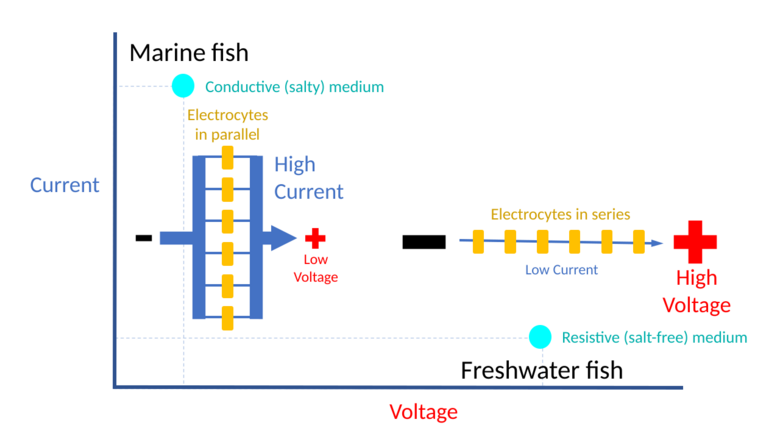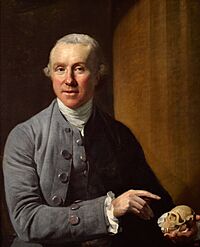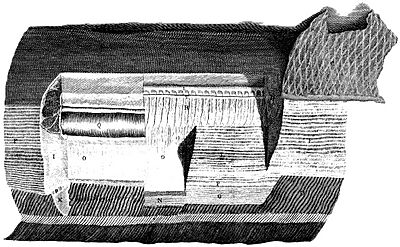Electric eel facts for kids
Quick facts for kids Electric eel |
|
|---|---|
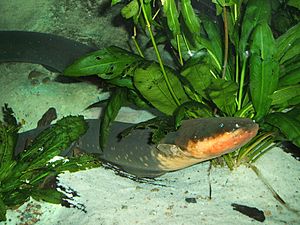 |
|
| Electrophorus electricus at the New England Aquarium | |
| Scientific classification |
|
| Kingdom: | Animalia |
| Phylum: | Chordata |
| Class: | Actinopterygii |
| Order: | Gymnotiformes |
| Family: | Gymnotidae Gill, 1872 |
| Genus: | Electrophorus Gill, 1864 |
| Type species | |
| Gymnotus electricus Linnaeus, 1766
|
|
| Species | |
|
see text |
|
Electric eels are a type of fish from South America famous for their amazing ability to create electricity. They can produce powerful shocks of up to 860 volts to stun their prey and defend themselves. Studying these fish even helped scientists invent the first electric battery back in 1800.
Despite their name, electric eels are not actually eels. They are a type of knifefish and are more closely related to catfish. For over 200 years, scientists thought there was only one species of electric eel. But in 2019, they discovered there are actually three different species!
These unique fish are active at night and have poor eyesight. They use a special sense called electrolocation to "see" the world around them with electricity. They are also one of the few fish that need to come to the surface to breathe air.
Contents
Not a True Eel
When the electric eel was first described by the famous scientist Carl Linnaeus in 1766, he named it Gymnotus electricus. He thought it was related to other knifefish. Later, in 1864, another scientist named Theodore Gill gave it its own genus, Electrophorus. The name comes from Greek words meaning 'electricity bearer'.
For a very long time, everyone believed there was only one species of electric eel. However, in 2019, a team of scientists studied the eel's DNA and physical features. They found enough differences to split them into three separate species. This was a huge discovery in the world of science!
The Three Species of Electric Eel
The three known species of electric eel look very similar, but they live in different parts of South America and have unique features.
- Electrophorus electricus This is the first species that was discovered. It is found in an area of South America called the Guiana Shield.
- Electrophorus voltai Named after Alessandro Volta, the inventor of the electric battery, this species is the strongest electricity generator of all animals. It can produce a shock of up to 860 volts!
- Electrophorus varii This species lives mostly in the lowland rivers and swamps of the Amazon basin.
Habitat and Hunting Habits
Electric eels live in the freshwaters of South America, like the Amazon and Orinoco river basins. They prefer muddy bottoms in rivers and swamps, often in shady areas. Because they can breathe air, they can survive in water that doesn't have much oxygen.
Electric eels are nocturnal, meaning they are most active at night. They are skilled predators that mainly eat other fish. They use their low-voltage electric sense to find prey in the dark. Once they locate a meal, they release a powerful, high-voltage shock to stun it before eating it.
Interestingly, some electric eels, like E. voltai, have been seen hunting in groups. They work together to herd smaller fish into a tight ball and then shock them all at once.

Biology
Body and Anatomy
Electric eels have long, snake-like bodies that can grow up to 2 meters (6.6 feet) long. Their skin is smooth and thick, usually dark brown or black with a yellow or orange belly. They don't have any scales.
Most of their important organs, like the heart and stomach, are packed into the front 20% of their body. The other 80% is filled with their special electric organs. They swim by moving their long anal fin in a wave-like motion.
One of the most unusual things about electric eels is that they are obligate air-breathers. This means they must come to the surface about every two minutes to gulp air. They use special tissues in their mouth to absorb oxygen. This allows them to live in muddy, low-oxygen water where other fish might not survive.
How the Shock Works
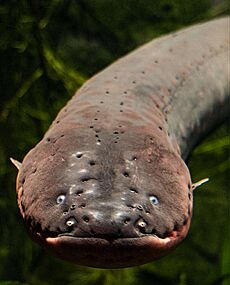
The electric eel's shock comes from three pairs of special organs: the main organ, Hunter's organ, and Sachs' organ. These organs are made of thousands of modified muscle cells called electrocytes.
Think of each electrocyte as a tiny biological battery. When the eel wants to shock something, its brain sends a signal. This signal causes thousands of these "batteries" to discharge all at once. Because the electrocytes are stacked in long rows, their power adds up to create a massive voltage. An eel can have around 6,000 electrocytes in a single row!
Low and High Voltage
Electric eels can produce two different kinds of shocks:
- Low-Voltage Pulses: The Sachs' organ produces weak pulses of about 10 volts. The eel uses this like a radar system for electrolocation. It helps them navigate and find prey in dark or murky water.
- High-Voltage Shocks: The main organ and Hunter's organ work together to create powerful shocks of 600 volts or more. These are used to stun prey or as a defense against predators. An eel can release hundreds of these high-voltage pulses in just a few seconds.
To make its shock even more powerful, an eel will often curl its body around its prey. This makes the electric current pass through the victim more effectively. They have even been seen leaping out of the water to shock threats on land!
Life Cycle
Electric eels breed during the dry season. The male builds a nest out of his own saliva for the female to lay her eggs in. A female can lay over 1,000 eggs.
After the eggs hatch, the young larvae will eat any leftover eggs for their first meal. The male parent is very protective and guards the nest and the young for several months.
Electric eels grow throughout their entire lives. They can live for a long time, with some in aquariums living for over 20 years.
Human Encounters and Discoveries
Humans have been fascinated and frightened by electric eels for centuries. Early explorers in South America wrote stories about these mysterious fish that could numb a person's body with a touch.
-
The surgeon John Hunter dissected an electric eel in 1775 to study its electric organs.
Humboldt's Famous Story
In 1800, the famous explorer Alexander von Humboldt wrote about a dramatic method used to catch electric eels. Local fishermen would drive a group of horses into a pond full of eels. The eels would attack the horses, leaping out of the water to deliver powerful shocks. After discharging their electricity many times, the tired eels were easy to catch with small harpoons.
Inspiring Science
The electric eel played a big role in the history of science.
- The First Battery: Studies of the eel's electricity in the late 1700s helped inspire Alessandro Volta to invent the first electric battery.
- Proving it's Electricity: In the 1830s, scientist Michael Faraday conducted many experiments on an electric eel. He proved that the shock it produced was the same as the electricity that created sparks and ran through wires.
Today, scientists are still studying electric eels. They hope to learn from the eel's efficient electric organs to design new types of power sources, perhaps for medical implants or other small devices.
Images for kids
-
An artist's drawing of Alexander von Humboldt's story of hunting electric eels with horses.
-
Michael Faraday's diagram of his experiment on an electric eel in 1838. He discovered the strongest shock was between the head (1) and tail (8).
See also
 In Spanish: Anguilas eléctricas para niños
In Spanish: Anguilas eléctricas para niños








